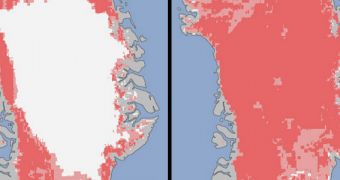Portions of Greenland's massive ice sheets have been melting faster over the past month than they have in over 30 years, announce investigators from the NASA Jet Propulsion Laboratory (JPL), in Pasadena, California. Unfortunately, this trend is likely to continue for the foreseeable future.
The discovery should be extremely worrying for everyone, since Greenland is the world's second-largest, ground-based ice reservoir after Antarctica. If all of its ices melt, global sea levels would rise by 21 feet (6.4 meters), making cities such as New York and Tokyo history.
For July, investigators looked exclusively at the surface ice cover. They found it to be melting at an extremely high pace, which affected areas spanning from the coasts all the way to the ice sheet's thickest point, in the middle of the island.
At its deepest, this ice field is 3.2 kilometers (2 miles) thick, scientists note. The melting spree affected all areas of the island to different extents, but no region was left unaffected. The measurements that led to this conclusion were produced by three different satellites conducting independent studies.
Both NASA and a consortium of university scientists analyzed the data, and they too arrived at the same conclusion. Statistically, nearly 50 percent of the island's entire surface melts during the summer. However, this year appears to be different, in that a lot more ice could melt.
Satellite data indicate that no less than 97 percent of the entire ice mass surface thawed at some point during the last 2 weeks. At this point, there is no way of knowing for sure whether the event will impact global sea levels right now.
“The Greenland ice sheet is a vast area with a varied history of change. This event, combined with other natural but uncommon phenomena, such as the large calving event last week on Petermann Glacier, are part of a complex story,” researcher Tom Wagner explains.
“Satellite observations are helping us understand how events like these may relate to one another as well as to the broader climate system,” adds the scientist, who is the cryosphere program manager at NASA Headquarters, in Washington DC.
According to experts at JPL, this level of pronounced melting has not occurred in Greenland since 1889, when modern weather records began being kept. The situation is extremely severe, and will continue to degenerate even further as global warming makes its effects with increased vigor.
At this point, scientists are still hopeful that the event is part of a larger cycle, which sees ices on the island declining severely every 150 years or so. However, if the same readings are collected next year, then external factors are definitely influencing the process.

 14 DAY TRIAL //
14 DAY TRIAL //